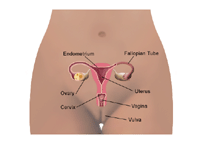Pelvic Inflammatory Disease (PID)
What is pelvic inflammatory disease?
 |
| Click Image to Enlarge |
Pelvic inflammatory disease (PID) is caused by bacteria.
PID can affect the uterus, fallopian tubes, and/or the ovaries. It can lead to pelvic adhesions and scar tissue that develops between internal organs, causing ongoing pelvic pain and the possibility of an ectopic pregnancy (the fertilized egg becomes implanted outside the uterus). If left untreated, PID can also lead to chronic infection. In addition, if PID is not diagnosed early enough, peritonitis and inflammation of the walls of the abdominal and pelvic cavity may develop.
Who is at risk for pelvic inflammatory disease?
Although women of any age can develop PID, those of childbearing age are at the greatest risk of acquiring the disease.
What are the symptoms of PID?
The following are the most common symptoms of PID. However, each individual may experience symptoms differently. Symptoms of PID include:
-
Diffuse pain and tenderness in the lower abdomen
-
Pelvic pain
-
Increased foul-smelling vaginal discharge
-
Fever and chills
-
Vomiting and nausea
-
Pain during urination
-
Abdominal pain (upper right area)
Symptoms may be mild enough that the condition may go undiagnosed.
The symptoms of pelvic inflammatory disease may resemble other conditions or medical problems. Always consult your health care provider for a diagnosis.
How is PID diagnosed?
In addition to a complete medical history and physical and pelvic examination, diagnostic procedures for PID may include the following:
-
Microscopic examination of samples from the vagina and cervix
-
Blood tests
-
Pap test. Test that involves microscopic examination of cells collected from the cervix, used to detect changes that may be cancer or may lead to cancer, and to show noncancerous conditions, such as infection or inflammation.
-
Ultrasound. A diagnostic imaging technique which uses high-frequency sound waves to create an image of the internal organs.
-
Laparoscopy. A minor surgical procedure in which a laparoscope, a thin tube with a lens and a light, is inserted into an incision in the abdominal wall. Using the laparoscope to see into the pelvic area, the physician can determine the locations, extent, and size of the endometrial growths.
-
Culdocentesis. A procedure in which a needle is inserted into the pelvic cavity through the vaginal wall to obtain a sample of pus.
Treatment for PID
Specific treatment for cervicitis will be determined by your health care provider based on:
-
Your age, overall health, and medical history
-
Extent of the disease
-
Type and severity of the symptoms
-
Your tolerance for specific medications, procedures, or therapies
-
Expectations for the course of the disease
-
Your opinion or preference
Treatment for PID usually includes oral antibiotics. In cases of severe infection, hospitalization may be required to administer intravenous antibiotics. Occasionally, surgery is necessary.
Click Online Resources of Women's Health for more information.